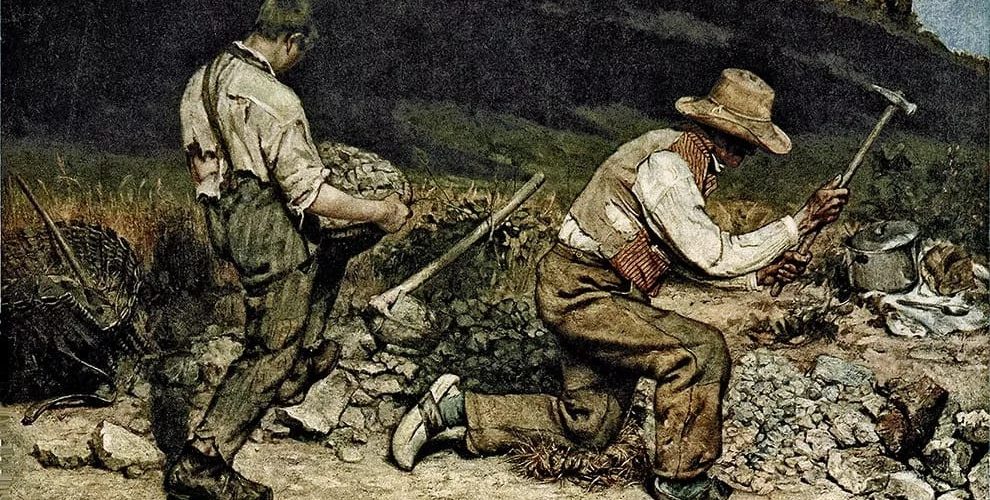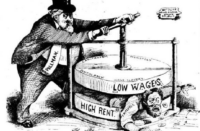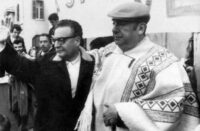The 200th anniversary of Gustave Courbet
A constant feature of any news programme in the capitalist world is “Business News” and reports from the stock markets. Those who toil to create the profits are always absent from the story.
This is particularly apparent to me, because I grew up in the German Democratic Republic, and at school even our literature books always included paintings with a working-class or socialist subject matter. Some of these left an indelible impression on me, so much so that I still think of them and occasionally look at them even all these decades later.
One of these paintings is Gustave Courbet’s paintings The Stone-Breakers.
Courbet painted The Stone-Breakers in his home town of Ornans, in eastern France, in 1849. He was thirty years old. Marx and Engels had published the Communist Manifesto the previous year, which stated as its opening fanfare: “The history of all hitherto existing society is the history of class struggles,” and “Society as a whole is more and more splitting up into two great hostile camps, into two great classes directly facing each other—Bourgeoisie and Proletariat.” This is the defining insight of the middle of the nineteenth century.
The Stone-Breakers depicts two roadside labourers, in almost life-size: 170 × 240 cm (67 × 94 in.). The labourers take up the greater part of the picture, emphasising the fact that they are the central figures and protagonists.
With the very recent proletarian uprisings of 1848, Courbet’s focus on the common people was radical. This image of two men, one only starting out in a life of hard labour and the other towards its end, expresses unrelenting hardship. Despite their arduous toil, these men just barely survive. Their clothes are badly torn and patched.
The colours in which they are painted blend with their place of work; the palette is dominated by shades of grey, bleached blues, earthy whites and browns. Rough brush-strokes translate the coarseness of the men’s clothing and their surroundings into tangible reality. There is no attempt to “beautify” the image by giving it a polished appearance, as would have been the painterly norm in Courbet’s time. This is a radical departure in theme and form.
The older man’s red striped waistcoat, near the centre of the picture, stands out. It is a statement of dignity and suggests the colour of the working class. Apart from that, however, combined with his white shirt and blue socks, this worker subtly displays the colours of the Tricolour, the French flag as it emerged in the Revolution of 1789. These colours once represented liberty, equality, and fraternity; what have they come to mean sixty years later in this bleached and torn form? This is without doubt a deliberate irony on the part of Courbet, especially as the colours adorn the older man, aged about seventy, according to Courbet. Courbet’s grandfather had been a sans-culotte (militant revolutionary) in 1789.
The two figures are etched sharply against a dark background, themselves throwing shadows that nearly merge with that of the low hill. Only in the upper right corner of the picture is there a patch of blue sky. The maturity of the corn behind them indicates early summer, as does the heat of the blazing sun. A large pot and a single spoon directly beside their place of work tells us that their whole life revolves around their labour. It also suggests that they are related. They eat on the side of the road; there is no private space.
We cannot make out the face of either man. The older man’s face is in profile, but only the lower part of it is visible under the straw hat, which casts a shadow over it. The younger man, lifting the broken stones, has his back turned. By not showing the faces clearly, Courbet focuses the viewer on the labour and its conditions, not appealing for sympathy but for insight, in almost Brechtian de-individualisation, preventing unreflective emotional involvement.
Courbet uses a similar technique in his great painting of women at work, The Winnowers. Here too, earthy reds, off-whites and blue dominate the palette. As in The Stone-Breakers, the central figure is adorned in red—here much more obviously so. Again, faces are either turned away, as in the main figure, looking down, or obscured by shadow, preventing eye contact with the viewer and thereby individualisation.
Once more the workers are shown at work, in the work-place, surrounded by the product of their work. And once again we see the lunch vessel in the picture, here at the centre back, with a ladle, and another one beside the sacks. The pots, plate, bowls and sacks echo the shape of the sieve, held up by the central figure in an energetic movement that contrasts with the more weary impression of the woman on her left. This tool is at the centre of the picture.
As in The Stone-Breakers, the workers toil in close proximity, but there is little connection or communication between them. All focus is on the labour. The unity of the composition is achieved by earthy colours, underlining the characters’ relationship with the soil, and by the many elliptical or round shapes uniting them.
In The Stone-Breakers the older man’s powerful hands stand out. His very strength and repetitive action, his less fluid, almost mechanised appearance, suggests a machine, and labourers as machines. Despite his age, he radiates strength and purpose. He is a force to be reckoned with. There is a great sense of dignity.
The younger man seems to be struggling more under the weight of the stone. He is newer to the job, not as mechanised in his movements. His clothes are even more ragged, his dusty shoes in tatters. Yet both figures possess a powerful physical presence, which is produced by the sun shining on them, light flowing round their bodies.
These two men express the lifelong toil of the working class and its condition. Their anonymity allows us to generalise. There is no sentimentality, and no idealisation. The artist conveys his sympathy for the workers, their dignity, and his disgust for a system that thrives on such poverty and exploitation.
Gustave Courbet was one of the first painters to make the life of workers the subject of realistic art. The Stone-Breakers, the first of his great realistic works, was destroyed in the bombing of Dresden in 1945.






